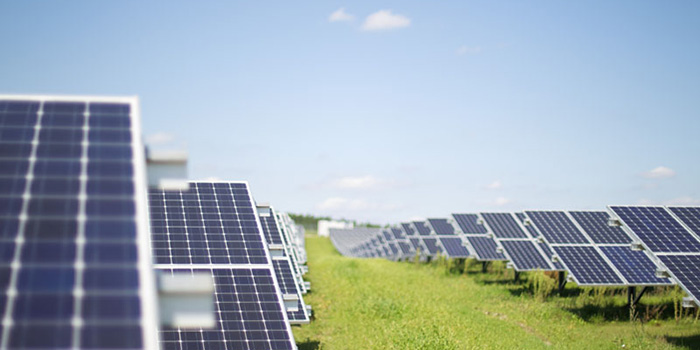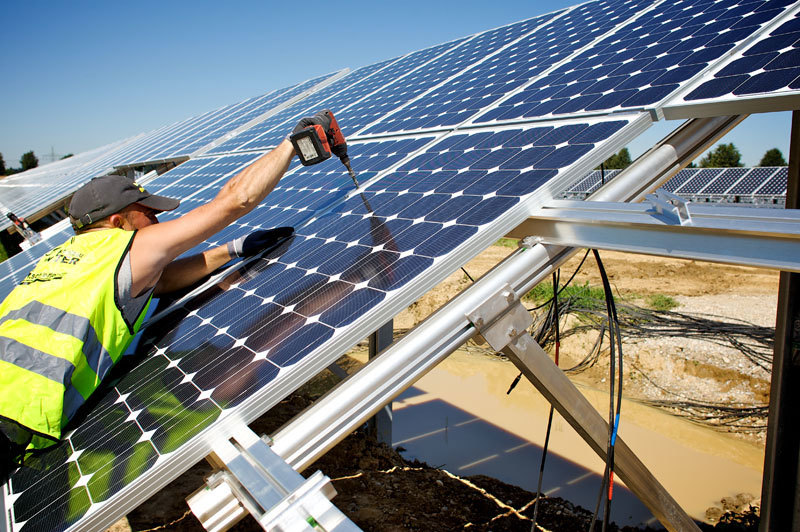Summary
– Presentation of solar thermal air conditioning
– Different cycles of solar thermal air conditioning
– Advantages of solar air conditioning: environmentally friendly air conditioning!
– Disadvantages of air conditioning with solar thermal panels
– Installation of an air conditioner with thermal solar panels
– Price of a solar air-conditioning system
There are two types of solar air conditioning: photovoltaic solar air conditioning and solar thermal air conditioning. Here we are dealing with air conditioners with solar thermal panels. It is an absorption or adsorption air conditioner; we then speak of thermal compression.
Presentation of solar thermal air conditioning
This time no more electricity is needed (except for circulators); mechanical compression is replaced by thermal compression created by the rise in temperature of the fluid inside. The heat comes from thermal solar panels. This process produces cold thanks to the fluid contained in the air conditioning unit.
This type of installation allows operation all year round, producing chilled water in summer (for air conditioning), hot water for heating in winter, and domestic hot water all year round. This installation reduces the payback time and optimizes the system.
Different cycles of solar thermal air-conditioning
Several types of solar thermal air conditioning exist. Differentiation can be made; we will speak of absorption or adsorption cycle, or open or closed cycle. Suppose you wish to take the plunge and equip yourself; only an expert in the field will advise you on your system choice according to your situation and the existing installation.
Absorption and adsorption: what’s the difference?

For both types of cycles, we will talk about a sorption system. The difference between the two comes from the sorbent. In the case of absorption, the sorbent is liquid. In the case of adsorption, the sorbent is solid. In practice, this difference does not change much for your installation; the operation is almost identical.
You will make the difference in the operating temperatures, the cost of the installation, and the air conditioner’s size and weight. Neither is better than the other; a cycle will be more or less appropriate depending on the installation’s characteristics to be carried out.
The open cycle
The open cycle is a system where there is the consumption of refrigerants. Water vaporized in the air, this water not being recovered, we speak of an open cycle. This open cycle is used in the tertiary sector because it requires an air treatment system with high flow rates. This cycle is called DEC (for desiccant evaporative cooling).
The blowing air will be treated to air-condition a room. It will first be dehumidified, then humidified by water vaporization. A physical principle is then exploited; the water vaporization in the air makes it possible to drop its temperature by a few degrees. The more the air is dried out, the more effective the cooling will be.
The closed cycle
The closed cycle includes the famous thermal compression, replacing the conventional air conditioner’s traditional electric compressor. This cycle is called trithermic because it requires three levels of temperature:
- A level of capture (the solar panels).
- A level of rejection to the outside air.
- A level of cold production.
- The room to be air-conditioned.
When the refrigerant charged with the sorbent is heated, its pressure will rise naturally. It is, therefore, a thermal compression. Compression is vital in air-conditioning because it allows obtaining two pressure levels, a low pressure (LP) and a high pressure (HP). The LP allows capturing the room’s heat to be air-conditioned, thus cooling it, while the HP allows rejecting the heat captured to the outside.
Advantages of solar air conditioning: ecological air conditioning!
The apparent advantage of such air conditioning is taking advantage of the sun’s free energy. You, therefore, significantly reduce your energy consumption for the air conditioning unit. Solar air-conditioning has the advantage of having an energy production that coincides with the demand, limiting the use of energy storage and thus avoiding unnecessarily raising the bill.
The heat produced can be used all year round to produce domestic hot water and supply the heating network in winter. The multiplication of uses for the same panel reduces the payback time.
Disadvantages of the air conditioner with thermal solar panels
However, it is essential to point out the few disadvantages of solar air conditioning. The main disadvantage of solar thermal air conditioning is the price of the air conditioner itself. As this technology is not yet widespread, prices are still very high.
Another major disadvantage is that these systems are designed for large to medium power (about 35 kW), but some manufacturers (Pink, Sortech, Invensor) market smaller air conditioners (at least about 8 to 10 kW) that are compatible with some single-family home installations. Besides, these are large machines.
The sunshine’s intermittency must be compensated for here, too, by using thermal storage tanks and using an electric or hydraulic boiler-type booster.
Installation of an air conditioner with solar thermal panels
A solar air conditioner is not as simple to install as a traditional air conditioner. It is important to call upon a professional who will be able to guide you towards the choice that best suits your needs, notably by carrying out a feasibility study. Indeed, these technologies are not adapted to all situations.
Unfortunately, there is not yet any sign of quality relating to the installation of solar air conditioners. On the other hand, for the installation of solar panels, quality signs do exist. For thermal solar panels, opt for a professional. Nothing guarantees their knowledge of solar air conditioning. However, a few companies are specializing in the field.
Price of a solar air conditioning
The price of a solar air-conditioning system varies according to, in particular, its type: photovoltaic or thermal. For thermal solar panels, prices range from $400 to $700 per m² of panels. For a single-family home, you should count between 20 and 30 m² depending on the panels’ location and type. For the air conditioner, plan for at least $10,000, plus all the necessary accessories (storage tank, electric booster, piping, valves, regulation).
For a 10 kW installation, the total envelope is $25,000. Don’t dwell on this significant figure, but remember that the system is capable (if properly sized) of producing air conditioning, heating, and domestic hot water almost free of charge year-round.
Good to know: It is possible to obtain some financial aid, especially in the framework of projects financing solar air-conditioning.

